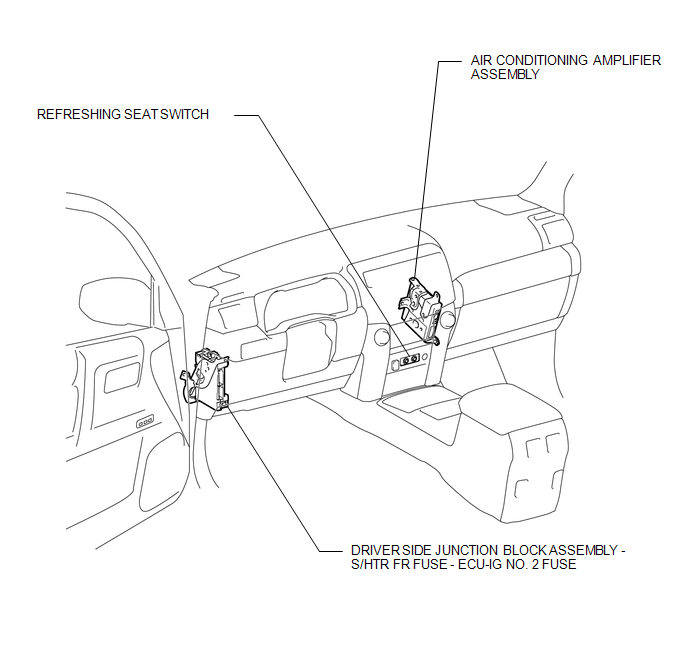The 2025 Toyota 4Runner and its Climate Control System: A Comprehensive Guide
Related Articles: The 2025 Toyota 4Runner and its Climate Control System: A Comprehensive Guide
Introduction
With great pleasure, we will explore the intriguing topic related to The 2025 Toyota 4Runner and its Climate Control System: A Comprehensive Guide. Let’s weave interesting information and offer fresh perspectives to the readers.
Table of Content
The 2025 Toyota 4Runner and its Climate Control System: A Comprehensive Guide

The 2025 Toyota 4Runner, known for its ruggedness and off-road capabilities, is also equipped with a sophisticated climate control system designed to provide comfort and convenience for its occupants. While the exact specifications and features of the 2025 model are yet to be officially released, it is highly likely that the 4Runner will continue to utilize a refrigerant, commonly referred to as "freon," within its air conditioning system. This refrigerant plays a crucial role in maintaining optimal cabin temperature and humidity levels, ensuring a pleasant driving experience.
Understanding the Importance of Refrigerant
Refrigerant, in the context of automotive air conditioning systems, is a fluid that undergoes a thermodynamic cycle, absorbing heat from the cabin air and transferring it to the exterior environment. This process facilitates cooling, providing a comfortable interior temperature even in hot weather conditions.
Key Properties of Refrigerant
- Low Boiling Point: Refrigerant possesses a low boiling point, enabling it to readily transition from liquid to gas at relatively low temperatures. This property is essential for efficient heat absorption.
- High Heat Capacity: Refrigerant can absorb a significant amount of heat without undergoing a substantial temperature change. This characteristic allows for effective heat removal from the cabin.
- Chemical Stability: Refrigerant should be chemically stable to ensure its longevity and prevent degradation over time.
- Environmental Compatibility: Modern automotive refrigerants are designed to minimize their environmental impact, reducing their potential to contribute to ozone depletion or global warming.
Evolution of Refrigerants in Automotive Air Conditioning
The automotive industry has witnessed a significant evolution in the types of refrigerants used in air conditioning systems. Early refrigerants, such as R-12 (chlorofluorocarbons or CFCs), were found to be detrimental to the ozone layer. Consequently, these refrigerants have been phased out, and newer, more environmentally friendly alternatives have been adopted.
Current automotive air conditioning systems commonly utilize refrigerants like R-134a (hydrofluorocarbons or HFCs), which have a lower ozone depletion potential compared to CFCs. However, HFCs still contribute to global warming, leading to ongoing research and development of even more sustainable alternatives.
Maintaining the Refrigerant System
The proper functioning of the 4Runner’s climate control system relies on maintaining the integrity of its refrigerant system. This includes ensuring adequate refrigerant levels, preventing leaks, and conducting regular inspections and maintenance.
Potential Issues and Solutions
- Low Refrigerant Levels: A decrease in refrigerant levels can result in reduced cooling efficiency. This issue can be addressed by adding refrigerant to the system, provided that no leaks are present.
- Refrigerant Leaks: Leaks can occur due to damage to the system’s components, such as hoses, seals, or the compressor. Repairing leaks is essential to prevent further refrigerant loss and maintain optimal performance.
- Compressor Failure: The compressor is a vital component responsible for circulating refrigerant through the system. Compressor failure can lead to a complete loss of air conditioning functionality and requires replacement.
Importance of Regular Maintenance
Regular maintenance of the 4Runner’s air conditioning system is crucial for optimal performance and longevity. This includes:
- Visual Inspection: Regularly inspect the system for any signs of leaks, damage, or wear.
- Refrigerant Level Check: Ensure adequate refrigerant levels are maintained.
- Compressor Function Test: Verify the compressor is operating efficiently.
- Air Filter Replacement: Replace the air filter to ensure proper airflow.
Addressing Common Concerns
FAQs
Q: What is the typical refrigerant used in the 2025 4Runner?
A: While the specific refrigerant for the 2025 model is not yet publicly available, it is likely to be an environmentally friendly alternative, such as R-134a or a newer, more sustainable option.
Q: How often should I have my 4Runner’s air conditioning system serviced?
A: It is recommended to have your air conditioning system inspected and serviced at least once a year, or more frequently if you notice any issues with cooling performance.
Q: What are the signs of a refrigerant leak?
A: Signs of a refrigerant leak may include a decrease in cooling efficiency, a hissing sound coming from the system, or the presence of oil or a sweet-smelling odor near the system’s components.
Q: Can I add refrigerant myself?
A: It is not recommended to add refrigerant yourself unless you are a certified technician. Incorrectly adding refrigerant can damage the system and lead to further complications.
Q: How do I find a qualified technician to service my air conditioning system?
A: Consult your Toyota dealership or a reputable automotive repair shop specializing in air conditioning systems.
Tips
- Regular Maintenance: Schedule regular maintenance for your 4Runner’s air conditioning system to prevent issues and ensure optimal performance.
- Avoid Overloading the System: Do not run the air conditioning system at its highest setting for extended periods, as this can strain the system and lead to premature wear.
- Proper Ventilation: Regularly ventilate the cabin to prevent the buildup of humidity and odors.
- Use a Cabin Air Filter: Replace the cabin air filter regularly to improve air quality and reduce allergens.
Conclusion
The 2025 Toyota 4Runner, like its predecessors, will likely feature a sophisticated climate control system utilizing a refrigerant to maintain comfortable cabin temperatures. Understanding the importance of refrigerant, its proper maintenance, and the potential issues that can arise will help 4Runner owners ensure optimal performance and longevity of their vehicle’s air conditioning system. By adhering to recommended maintenance practices and addressing any issues promptly, owners can enjoy a comfortable and enjoyable driving experience regardless of the weather conditions.








Closure
Thus, we hope this article has provided valuable insights into The 2025 Toyota 4Runner and its Climate Control System: A Comprehensive Guide. We appreciate your attention to our article. See you in our next article!
